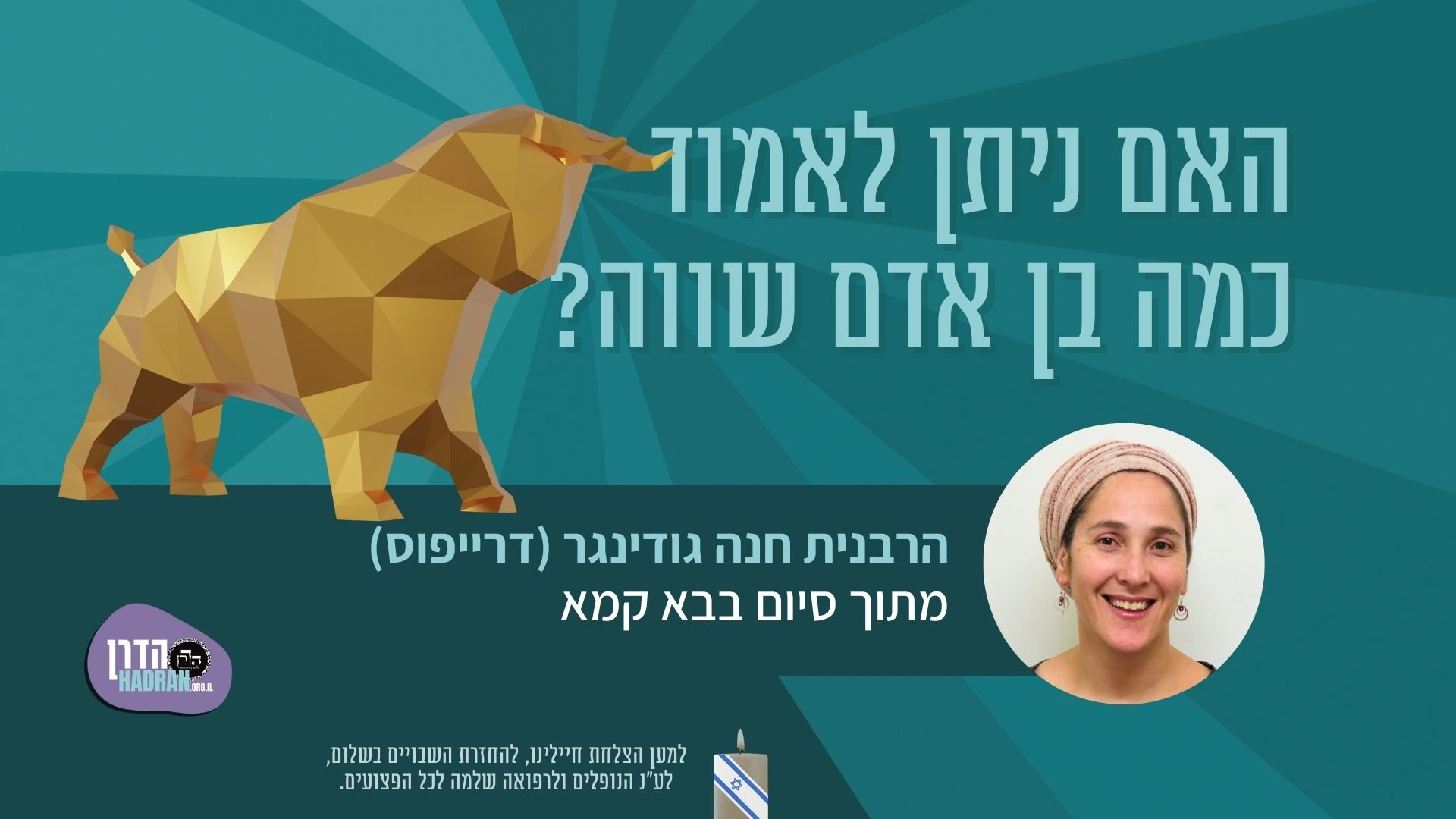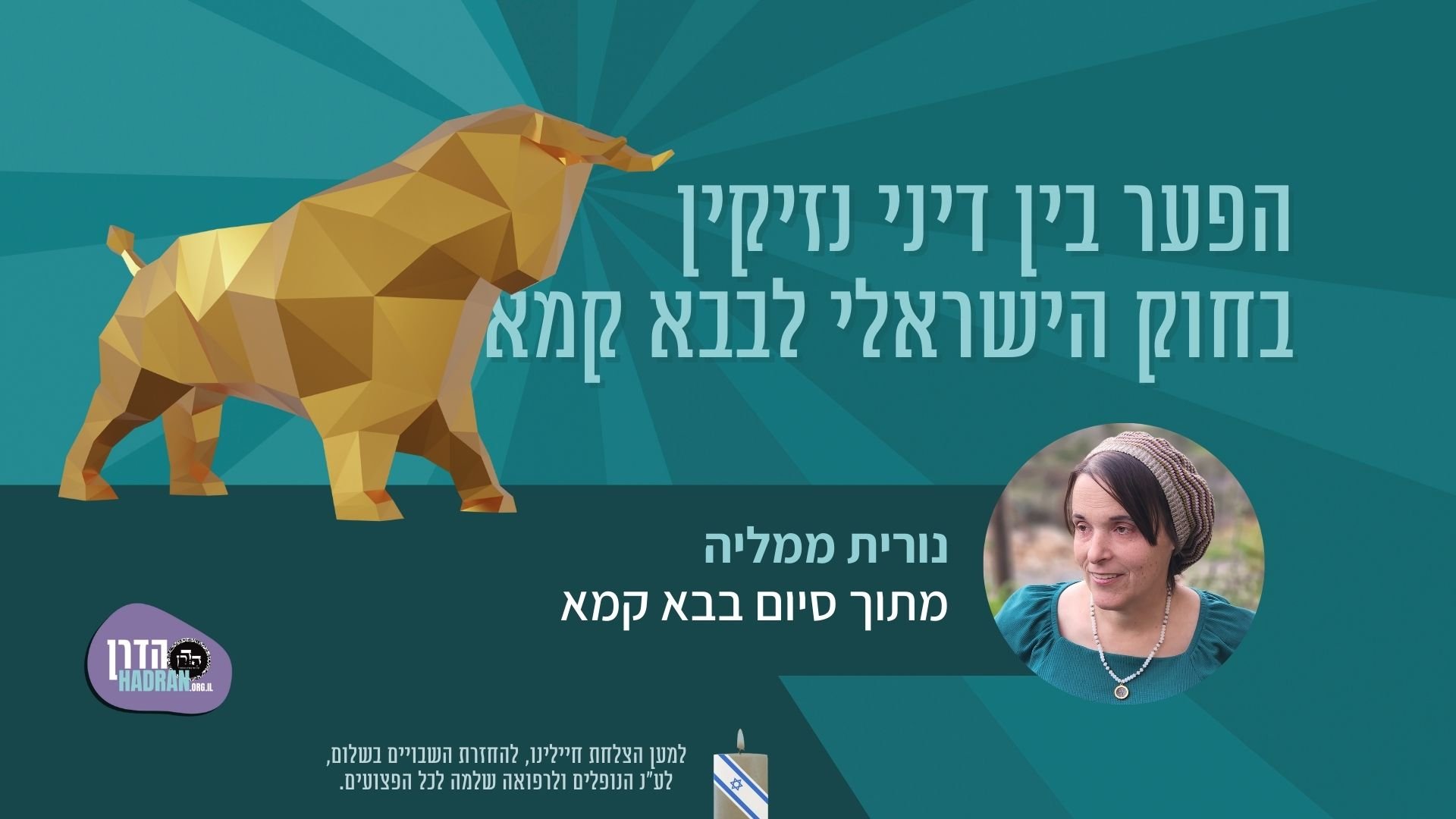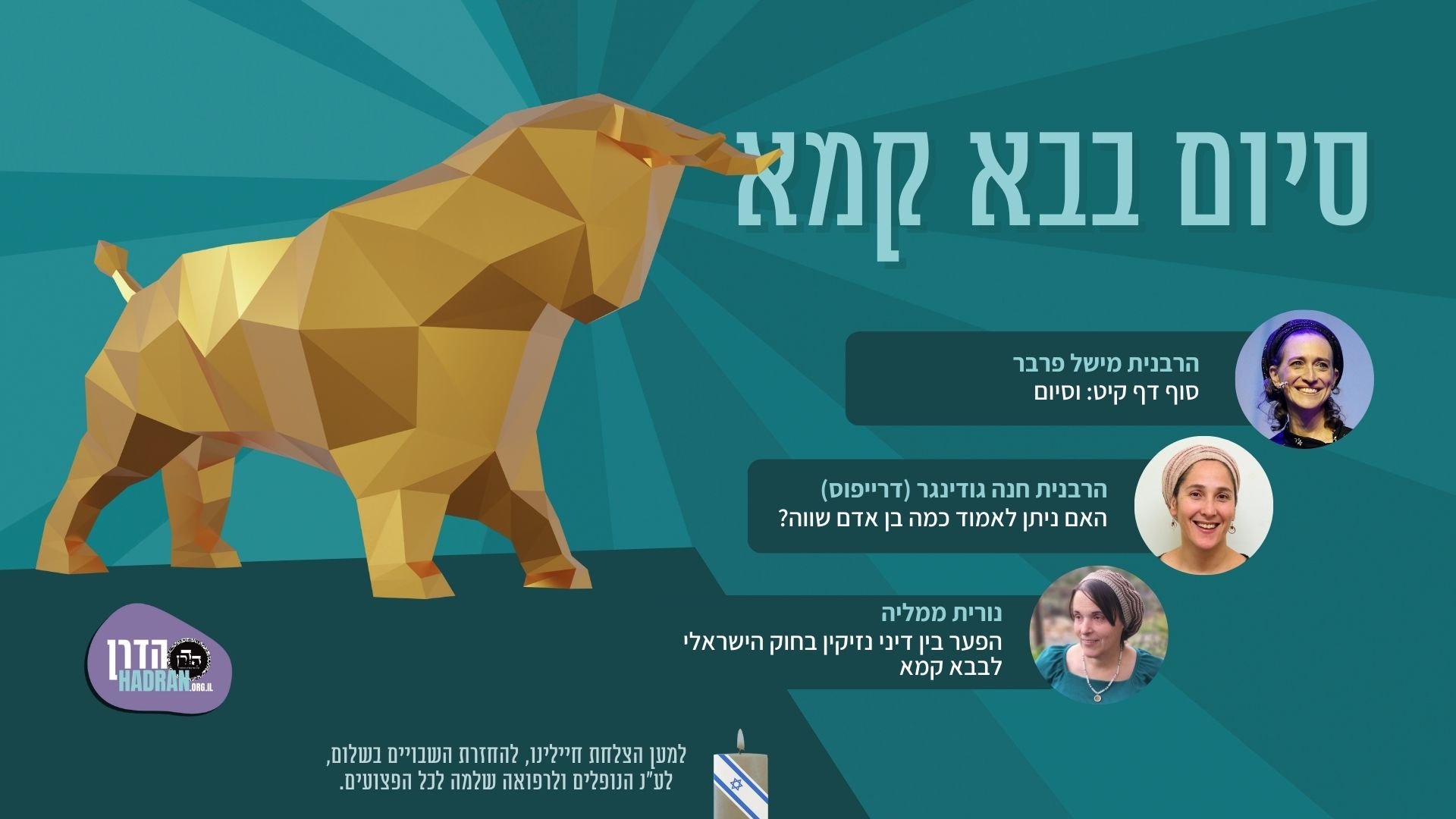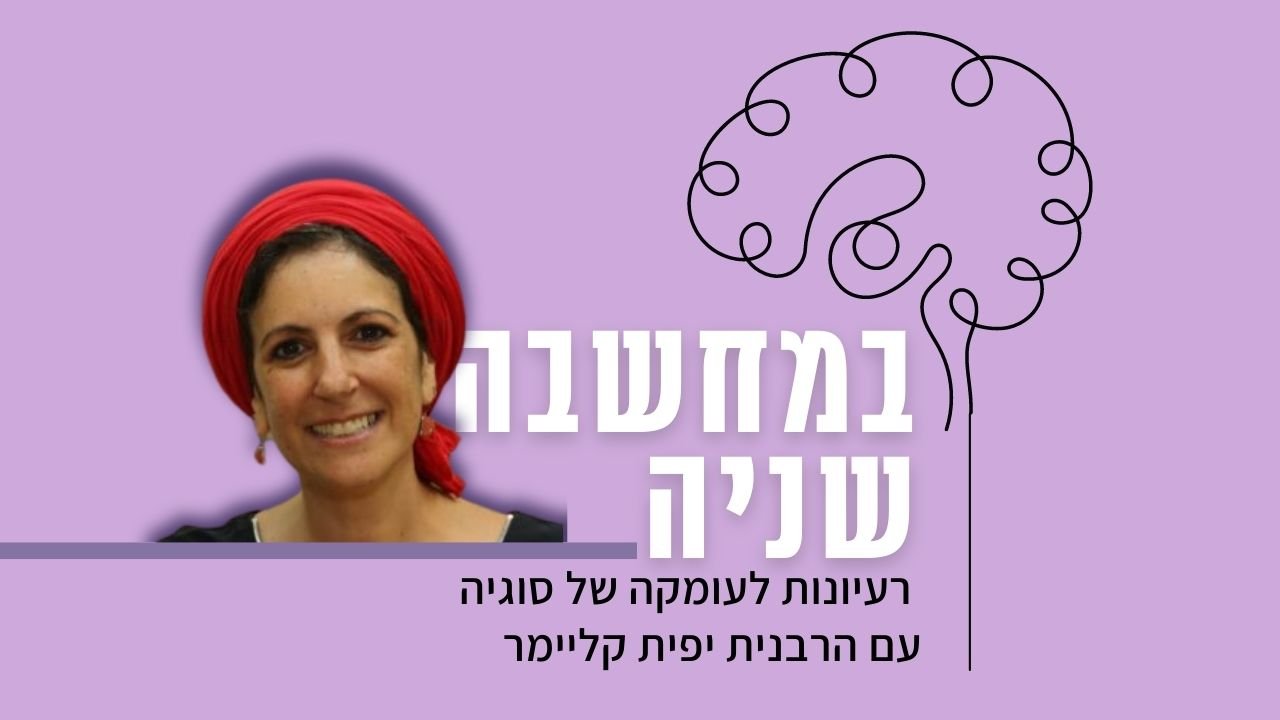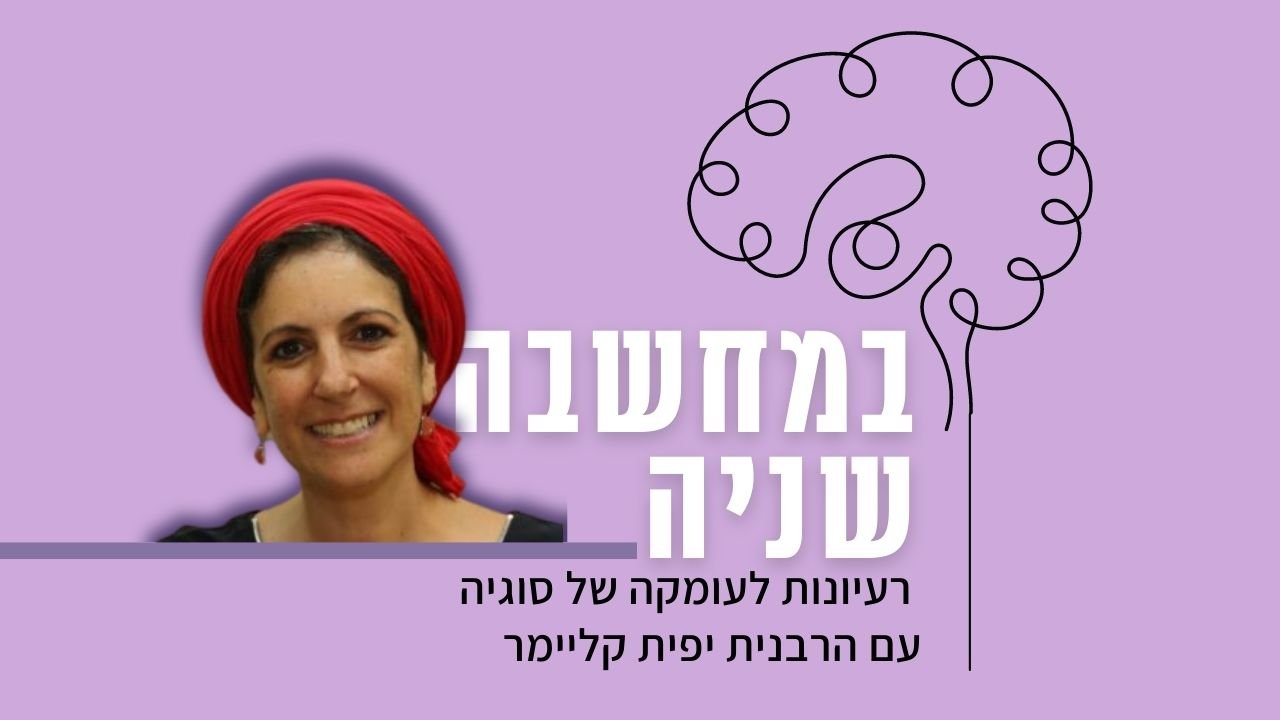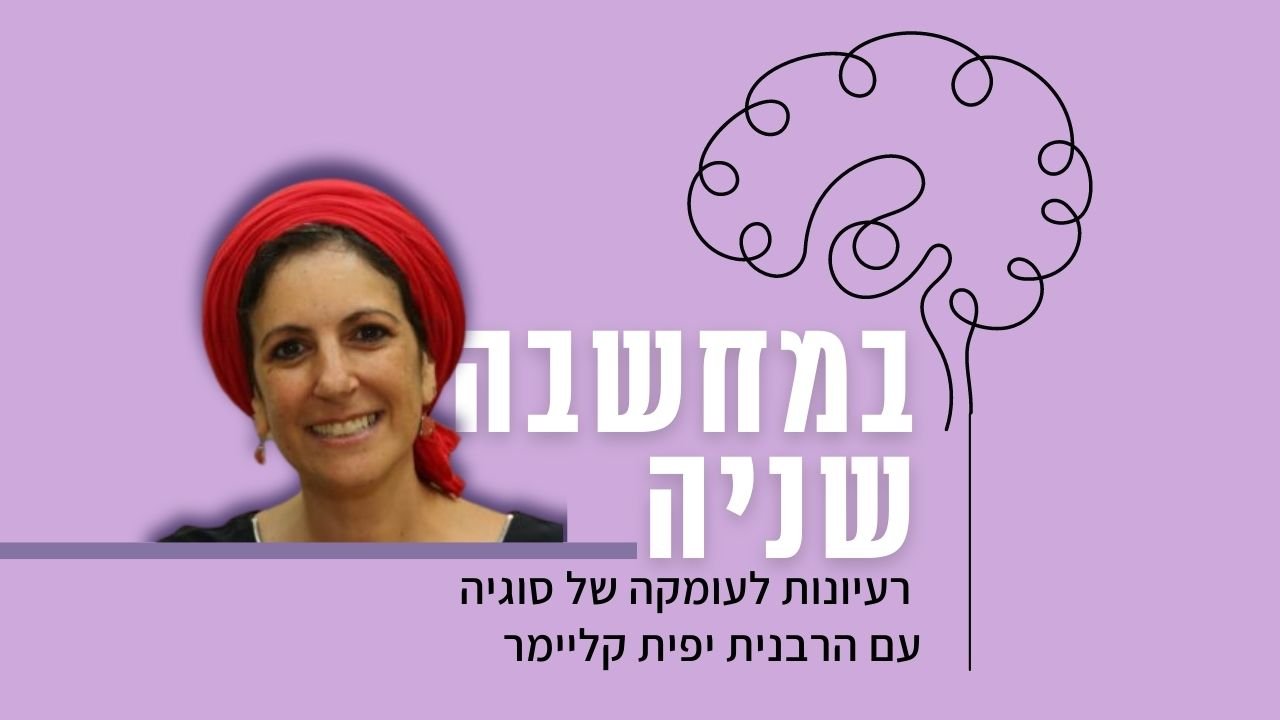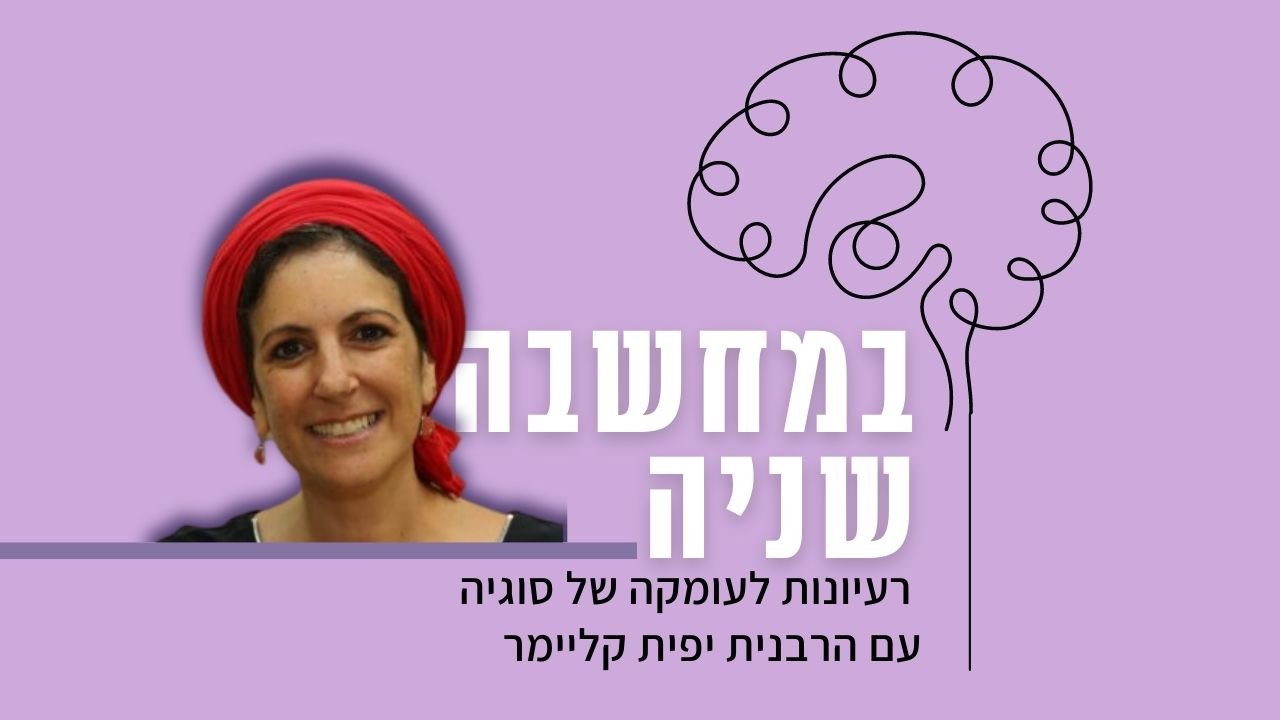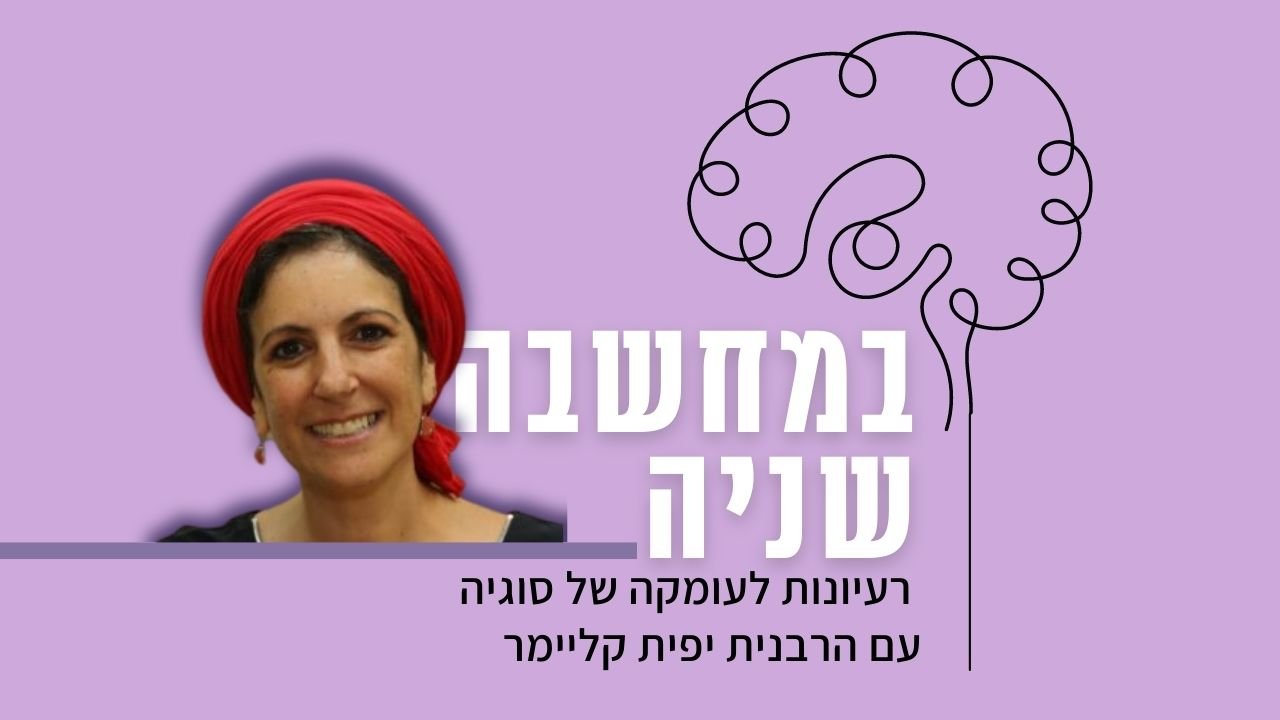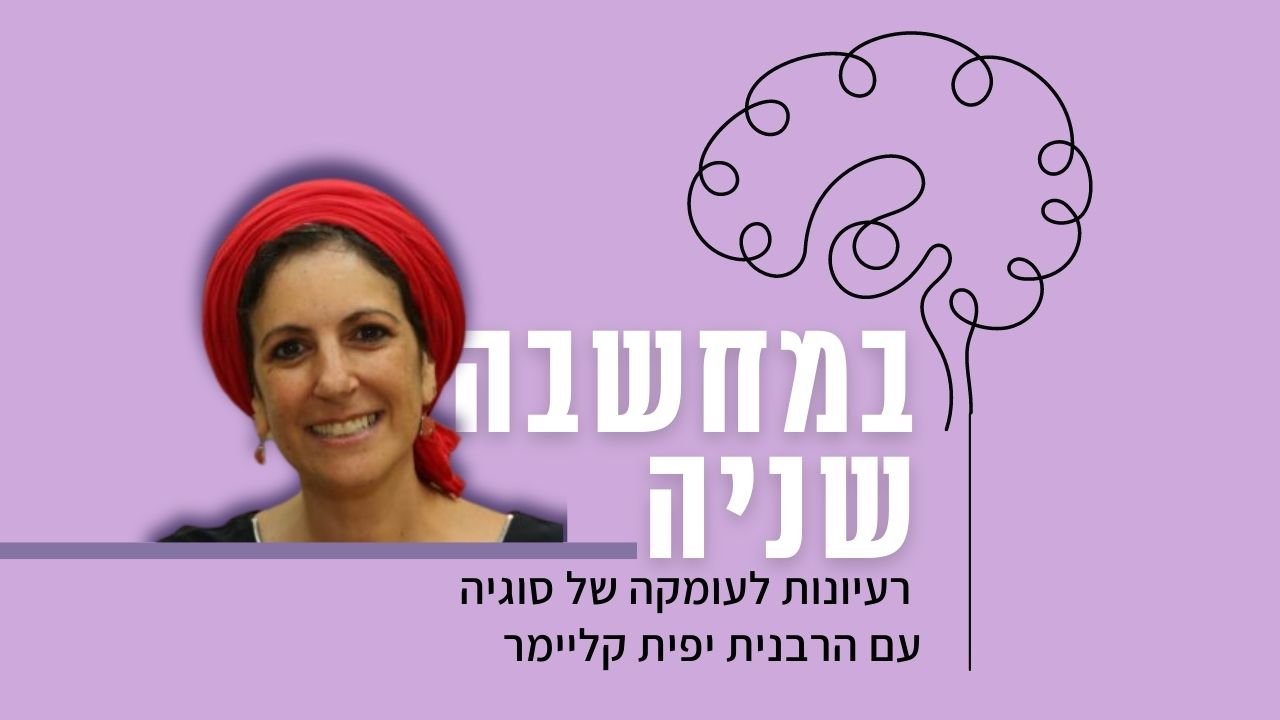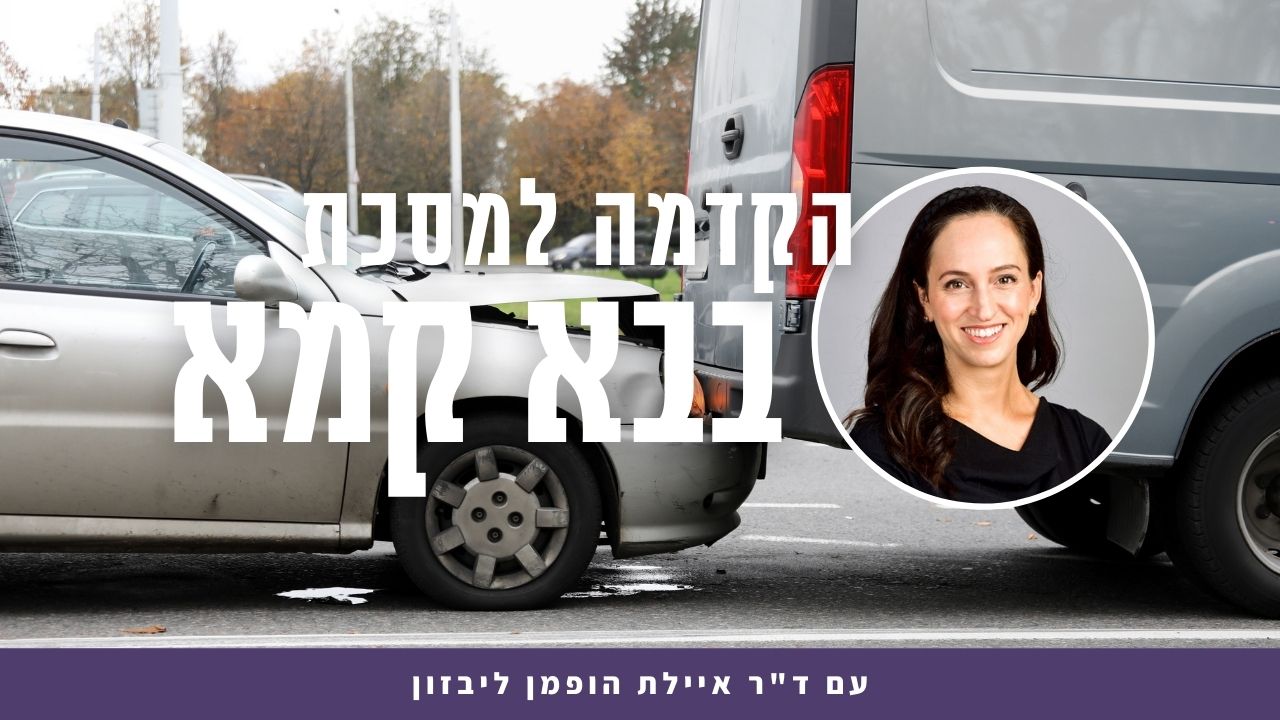רבי אושעיא מנה שלוש עשרה קטגוריות של נזקים ולרבי חייא היו עשרים וארבע. מדוע רבי אושעיא לא כלל את כל הקטגוריות שרבי חייא כלל? המשנה, רבי אושעיא ורבי חייא פירטו כל אחד כמה קטגוריות עיקריות יש (4, 13, 24). ההנחה היא שכאשר מציינים מספר הוא שם כדי לחלוק על מי שחושב שיש יותר. מה בא כל אחד למעט בזה שהוסיף מספר לרשימתו? מדוע התייחסו רבי אושעיא ורבי חייא לקטיגוריות כאבות אם אין להם תולדות כמו האבות במשנה? האם הזכירה המשנה את כל ההבדלים בין האבות כדי להראות מדוע אנו צריכים למנות כל אחד, שכן לא יכולנו ללמוד אחד מהשני? או שכן היה אפשר להפיק אותם כולם מאב אחד או שניים? אם אפשר היה, אז למה הזכירו את ההבדלים בין כל אחד מהם? כי יש לכל אחד הלכות מיוחדות שאין לשאר.
הלימוד השבוע מוקדש ע”י רוברט ופאולה כהן לע”נ יוסף בן משה הכהן ז”ל. יוסף היה חזן שאהב מאוד לשיר, עבד קשה בחייו והיה מאוד מסור למשפחתו ולקהילה.
רוצה להקדיש שיעור?

כלים
הלימוד השבוע מוקדש ע”י רוברט ופאולה כהן לע”נ יוסף בן משה הכהן ז”ל. יוסף היה חזן שאהב מאוד לשיר, עבד קשה בחייו והיה מאוד מסור למשפחתו ולקהילה.
כלים
העמקה
רוצה להבין מה באמת קורה מתחת לפני השטח של הסוגיה?
שיעורים, פודקאסטים והרחבות של מיטב המורות שלנו יפתחו לך עוד זוויות וכיווני חשיבה.
חדשה בלימוד הגמרא?
זה הדף הראשון שלך? איזו התרגשות עצומה! יש לנו בדיוק את התכנים והכלים שיעזרו לך לעשות את הצעדים הראשונים ללמידה בקצב וברמה שלך, כך תוכלי להרגיש בנוח גם בתוך הסוגיות המורכבות ומאתגרות.
פסיפס הלומדות שלנו
גלי את קהילת הלומדות שלנו, מגוון נשים, רקעים וסיפורים. כולן חלק מתנועה ומסע מרגש ועוצמתי.
בבא קמא ה
עֵדִים זוֹמְמִין, דְּמָמוֹנָא הוּא, לִיתְנֵי! סָבַר לַהּ כְּרַבִּי עֲקִיבָא, דְּאָמַר: אֵין מְשַׁלְּמִין עַל פִּי עַצְמָן.
The Gemara asks: With regard to the payment made by conspiring witnesses, which is categorized as monetary restitution, as the witnesses pay the precise sum that they conspired to cause the defendant to lose, let Rabbi Oshaya also teach it as one of the categories on his list. The Gemara answers: Rabbi Oshaya holds in accordance with the opinion of Rabbi Akiva, who says that conspiring witnesses do not pay on the basis of their own admission. Evidently, theirs is not a payment of monetary restitution; rather, it is a fine, as only one who was found liable based on the testimony of witnesses pays a fine, not one who was found liable based on his own admission.
אִי סָבַר לֵיהּ כְּרַבִּי עֲקִיבָא, לִיתְנֵי תְּרֵי גַוְונֵי שׁוֹר – לִיתְנֵי שׁוֹר דְּאַזֵּיק שׁוֹר, וְלִיתְנֵי שׁוֹר דְּאַזֵּיק אָדָם;
The Gemara asks: If Rabbi Oshaya holds in accordance with the opinion of Rabbi Akiva, let him teach two distinct types of categories of damage under the rubric of Ox: Let him teach one category for an ox that damages an ox or other property belonging to another person, and let him also teach the case of an ox that injures a person.
דִּתְנַן, רַבִּי עֲקִיבָא אוֹמֵר: אַף תָּם שֶׁחָבַל בְּאָדָם – מְשַׁלֵּם בַּמּוֹתָר נֶזֶק שָׁלֵם!
The Gemara explains its question: As we learned in a mishna (33a): In a case where the two parties damaged each other concurrently, Rabbi Akiva says: The owner of the innocuous ox that injured a person also pays the full cost of the damage with regard to the difference between the damage caused by his ox and the damage that the person caused the ox. Rabbi Akiva holds that if an innocuous ox injures a person, the owner pays the full cost of the damage, whereas if an innocuous ox damages another’s property then the owner is liable only for half the cost of the damage. Since the owner’s liability in the two cases is different, each case should be classified as a distinct category, and Rabbi Oshaya should list them separately in his baraita.
הָא תַּבְרֵיהּ רַבִּי עֲקִיבָא לִגְזִיזֵיהּ; דְּתַנְיָא, רַבִּי עֲקִיבָא אוֹמֵר: יָכוֹל אַף תָּם שֶׁחָבַל בְּאָדָם, יְשַׁלֵּם מִן הָעֲלִיָּיה – תַּלְמוּד לוֹמַר: ״יֵעָשֶׂה לוֹ״ – מִגּוּפוֹ מְשַׁלֵּם, וְאֵינוֹ מְשַׁלֵּם מִן הָעֲלִיָּיה.
The Gemara answers: Didn’t Rabbi Akiva break the force of his fist [gezizeih], i.e., he significantly tempered the force of his statement, as it is taught in a baraita that Rabbi Akiva says: One might have thought that even in the case of an innocuous ox that injured a person, the owner of the ox would pay from his superior-quality property and not merely from the body of his animal, as in the case of an innocuous ox that damages property; therefore, the verse states with regard to an ox that gores a person: “According to this judgment shall it be done to him” (Exodus 21:31), from which it is derived that the owner of the ox pays restitution exclusively from proceeds of the sale of the body of his ox, and he does not pay from his superior-quality property. The mishna states that one pays restitution from his superior-quality property in instances of all primary categories of damage. Since in the case of an innocuous ox that injured a person even Rabbi Akiva concedes that the owner does not pay from his superior-quality property, it should not be included in a list of the primary categories.
הָאוֹנֶס וְהַמְפַתֶּה וְהַמּוֹצִיא שֵׁם רַע, דְּמָמוֹנָא הוּא, לִיתְנֵי!
The Gemara asks: As for the rapist, and the seducer, and the defamer, all of which are cases in which the offender pays monetary restitution, let Rabbi Oshaya teach them as categories in his list.
מָה נַפְשָׁךְ; אִי נֵזֶק – תְּנָא לֵיהּ, אִי צַעַר – תְּנָא לֵיהּ, אִי בּשֶׁת – תְּנָא לֵיהּ, אִי פְּגָם – הַיְינוּ נֵזֶק. מָה אִית לָךְ לְמֵימַר – קְנָסָא? בִּקְנָסָא לָא קָמַיְירֵי.
The Gemara explains why Rabbi Oshaya did not teach them as separate categories: Whichever way you look at it, they should not be listed. If the payments listed by Rabbi Ḥiyya are for damage caused to the woman’s body, which reduces her value, he already taught it; if the payments are for pain, he already taught it; if the payments are for humiliation, he already taught it; if the payment is for degradation, that too is a payment for damage, which he already taught. What, then, have you to say? What is the nature of the payments paid by the rapist and the seducer mentioned by Rabbi Ḥiyya? In these cases, each payment paid is considered a fine [kenasa], and as explained, with regard to cases in which one is liable to pay a fine, Rabbi Oshaya does not speak.
הַמְטַמֵּא וְהַמְדַמֵּעַ וְהַמְנַסֵּךְ, דְּמָמוֹנָא הוּא, לִיתְנֵי!
The Gemara asks further: And one who causes another’s teruma to become ritually impure, and one who mixes teruma with another’s non-sacred food, and one who pours another’s wine as a libation for idolatry, each of which is a case in which the offender must pay monetary restitution to compensate the owner for his loss due to the lowered value of his food or wine, let Rabbi Oshaya teach them as categories in his list.
מָה נַפְשָׁךְ; אִי הֶיזֵּק שֶׁאֵינוֹ נִיכָּר שְׁמֵיהּ הֶיזֵּק – הָא תְּנָא לֵיהּ נֵזֶק, אִי הֶיזֵּק שֶׁאֵינוֹ נִיכָּר לָא שְׁמֵיהּ הֶיזֵּק – הָוֵה לֵיהּ קְנָסָא, וּבִקְנָסָא לָא קָמַיְירֵי.
The Gemara answers: Whichever way you look at it, these cases should not be listed. If Rabbi Oshaya holds that damage that is not evident, i.e., where the object is physically unchanged but its halakhic status is changed, is characterized as damage for which one is liable to pay restitution, Rabbi Oshaya already taught, i.e., included in his list, restitution for damage, and if he holds that damage that is not evident is not characterized as damage for which one is liable to pay restitution, then it is a fine, and, as explained, with regard to cases for which one is liable to pay a fine, Rabbi Oshaya does not speak.
לֵימָא קָסָבַר רַבִּי חִיָּיא הֶיזֵּק שֶׁאֵינוֹ נִיכָּר לָא שְׁמֵיהּ הֶיזֵּק? דְּאִי שְׁמֵיהּ הֶיזֵּק, הָא תְּנָא לֵיהּ נֵזֶק! תְּנָא הֶיזֵּקָא דְּמִינַּכְרָא, וּתְנָא הֶיזֵּקָא דְּלָא מִינַּכְרָא.
The Gemara suggests: Since Rabbi Ḥiyya lists these cases as distinct categories, let us say that Rabbi Ḥiyya holds that damage that is not evident is not characterized as damage for which one is liable to pay restitution, as, if it were characterized as damage for which one is liable to pay restitution, didn’t he already teach, i.e., include in his list, restitution for damage? The Gemara rejects that suggestion: Even if he holds that damage that is evident is characterized as damage for which one is liable to pay restitution, he distinguishes between different types of damage. He teaches cases of damage that is evident and he teaches cases of damage that is not evident.
בִּשְׁלָמָא לְתַנָּא דִּידַן, תְּנָא מִנְיָינָא – לְמַעוֹטֵי דְּרַבִּי אוֹשַׁעְיָא, וְרַבִּי אוֹשַׁעְיָא תְּנָא מִנְיָינָא – לְמַעוֹטֵי דְּרַבִּי חִיָּיא. אֶלָּא מִנְיָינָא דְּרַבִּי חִיָּיא, לְמַעוֹטֵי מַאי?
The Gemara considers the fact that each of the lists of primary categories is introduced with the number that they total: Granted, according to the tanna of our mishna, he taught the number of four primary categories in introducing his list to exclude those additional categories of Rabbi Oshaya. And similarly, Rabbi Oshaya taught the number of thirteen primary categories to exclude those additional categories of Rabbi Ḥiyya. But what does the number of twenty-four primary categories of Rabbi Ḥiyya serve to exclude?
לְמַעוֹטֵי מוֹסֵר וּמְפַגֵּל.
The Gemara answers: He taught that number in order to exclude the cases of an informer, who provides information to the authorities leading them to confiscate another person’s property; and to exclude the case of a priest who renders an offering piggul by performing the sacrificial rites for one offering with the intent to sacrifice it for the sake of another offering, in which case the person who brought the offering must replace it with another.
וְלִיתְנֵי! בִּשְׁלָמָא מְפַגֵּל – בְּקָדָשִׁים לָא קָמַיְירֵי. אֶלָּא מוֹסֵר, מַאי טַעְמָא לָא תָּנֵי? שָׁאנֵי מוֹסֵר – דְּדִיבּוּרָא, וּבְדִיבּוּרָא לָא קָמַיְירֵי.
The Gemara asks: And let Rabbi Ḥiyya teach these cases. Granted, he did not include the case of a priest who renders an offering piggul. Perhaps, with regard to cases involving consecrated items, Rabbi Ḥiyya does not speak. But with regard to the case of an informer, what is the reason Rabbi Ḥiyya did not teach it and include it in his list of categories? The Gemara answers: The case of an informer is different, as the damage is caused through speech, and with regard to damage caused through speech, Rabbi Ḥiyya does not speak.
וְהָא מוֹצִיא שֵׁם רַע, דְּדִיבּוּרָא הוּא, וְקָתָנֵי! דִּיבּוּרָא דְּאִית בֵּיהּ מַעֲשֶׂה הוּא.
The Gemara asks: But isn’t there the case of a defamer, where the damage is caused through speech, and yet Rabbi Ḥiyya teaches it and includes it in his list? The Gemara answers: He includes that case because it is a case of speech that involves an action. One who defames his wife is liable only if he made his allegation after engaging in intercourse with her.
וְהָא עֵדִים זוֹמְמִין – דִּיבּוּרָא דְּלֵית בֵּיהּ מַעֲשֶׂה הוּא, וְקָתָנֵי! הָתָם, אַף עַל גַּב דְּלֵית בֵּיהּ מַעֲשֶׂה, רַחֲמָנָא קַרְיֵיהּ מַעֲשֶׂה – דִּכְתִיב: ״וַעֲשִׂיתֶם לוֹ כַּאֲשֶׁר זָמַם לַעֲשׂוֹת לְאָחִיו״.
The Gemara asks: But isn’t the case of conspiring witnesses a case of speech that involves no action, as they are liable for their testimony, and Rabbi Ḥiyya teaches it and includes it in his list? The Gemara answers: There, although it involves no action, the Merciful One characterizes it as an action, as it is written: “And you shall do to him as he conspired to do unto his brother” (Deuteronomy 19:19).
בִּשְׁלָמָא לְתַנָּא דִּידַן, תַּנָּא ״אָבוֹת״ – מִכְּלָל דְּאִיכָּא תּוֹלְדוֹת; אֶלָּא לְרַבִּי חִיָּיא וְרַבִּי אוֹשַׁעְיָא, ״אָבוֹת״ – מִכְּלָל דְּאִיכָּא תּוֹלְדוֹת?! תּוֹלְדוֹתֵיהֶן מַאי נִיהוּ?
The Gemara considers the subcategories of the various primary categories listed: Granted, according to the tanna of our mishna, his terminology is understandable, as he taught primary categories, which, by inference, means that there are also additional forms of damage that are subcategories of those primary categories. But according to Rabbi Ḥiyya and Rabbi Oshaya, why did they employ the terminology they employed? They employed the term primary categories, which, by inference, means that there are subcategories. What are the subcategories of the primary categories they listed? It appears that they enumerated all the various categories of damage.
אָמַר רַבִּי אֲבָהוּ: כּוּלָּן כְּאָבוֹת לְשַׁלֵּם מִמֵּיטַב.
Rabbi Abbahu says: When Rabbi Ḥiyya and Rabbi Oshaya characterize, as primary categories, the various categories of damage that they listed, it is not to indicate that there are subcategories; rather, it is to indicate that all of them are characterized as primary categories, in the sense that one is liable to pay from one’s best-quality property.
מַאי טַעְמָא? אַתְיָא ״תַּחַת״, ״נְתִינָה״, ״יְשַׁלֵּם״, ״כֶּסֶף״.
The Gemara asks: What is the reason for this, i.e., from where is it derived? The Gemara explains: It is derived using a verbal analogy from the terms “in place of,” “giving,” “he shall pay,” and “money.” The term “in place of” is written with regard to a forewarned ox that gores (Exodus 21:36); “he shall give” is written with regard to an ox that kills a slave (Exodus 21:32); “he shall pay” is written with regard to the categories of damage of Eating and Trampling (Exodus 22:4); and “money” is written with regard to Pit (Exodus 21:34). The halakha that one must pay from his best-quality property is stated explicitly in each of those four verses. In each of the twenty-four categories listed by Rabbi Ḥiyya one of those four terms is written, so by means of a verbal analogy, the requirement to pay from one’s best-quality property applies to each of them.
לֹא הֲרֵי הַשּׁוֹר כַּהֲרֵי הַמַּבְעֶה. מַאי קָאָמַר? אָמַר רַב זְבִיד מִשְּׁמֵיהּ דְּרָבָא: הָכִי קָאָמַר – לִכְתּוֹב רַחֲמָנָא חֲדָא, וְתֵיתֵי אִידַּךְ מִינֵּיהּ; הֲדַר אֲמַר: חֲדָא מֵחֲדָא לָא אָתְיָא.
§ The mishna states: The defining characteristic of the primary category of Ox is not similar to the defining characteristic of the primary category of Maveh. The Gemara asks: What is the mishna saying? Rav Zevid said in the name of Rava that this is what the mishna is saying: Let the Merciful One write one of the primary categories and derive the other categories from it. Then the tanna says: It is not possible to derive one category from one other category, as each category has its unique characteristics.
וְלֹא זֶה וָזֶה שֶׁיֵּשׁ בָּהֶן רוּחַ חַיִּים. מַאי קָאָמַר? אָמַר רַב מְשַׁרְשְׁיָא מִשְּׁמֵיהּ דְּרָבָא: הָכִי קָאָמַר –
The mishna continues: And the defining characteristics of this category of Ox and that category of Maveh, in which there is a living spirit, are not similar to the defining characteristic of the category of Fire, in which there is no living spirit. The Gemara asks: What is the tanna saying? Rav Mesharshiyya said in the name of Rava that this is what the tanna is saying:
לִכְתּוֹב רַחֲמָנָא תַּרְתֵּי, וְתֵיתֵי אִידַּךְ מִינַּיְיהוּ; הֲדַר אָמַר: חֲדָא מִתַּרְתֵּי לָא אָתֵי.
Let the Merciful One write only two of the primary categories and derive the other categories from them. Then the tanna says: It is not possible to derive one category from two other categories, as each category has its own unique characteristics, which prevent the derivation of a new category even from a combination of two categories.
אָמַר רָבָא: וְכוּלְּהוּ כִּי שָׁדֵית בּוֹר בֵּינַיְיהוּ – אָתְיָא כּוּלְּהוּ בַּמֶּה הַצַּד, לְבַר מִקֶּרֶן; מִשּׁוּם דְּאִיכָּא לְמִיפְרַךְ, מָה לְכוּלְּהוּ שֶׁכֵּן מוּעָדִין מִתְּחִילָּתָן.
Rava said: And with regard to all of the primary categories in the mishna, when you cast the primary category of Pit among them, all of the rest of them can then be derived through an analogy based on the common factor of two categories. This is the case with all of the categories except for Goring, due to the fact that there is room to refute the analogy to teach the halakha of Goring with the following contention: What is notable about all of the other categories? They are notable in that they are forewarned from their outset. Since it is the typical manner of the animal to trample and eat, and the typical manner of fire to burn, and the typical manner of a pit to serve as an obstacle, the owner is always forewarned with regard to safeguarding against damage and is liable to pay full damages for his failure to prevent the damage even the first time. With regard to Goring, the animal is innocuous for the first three instances of damage and only thereafter is the animal forewarned, rendering its owner liable to pay full damages.
וּלְמַאן דְּאָמַר: אַדְּרַבָּה, קֶרֶן עֲדִיפָא – שֶׁכַּוּוֹנָתוֹ לְהַזִּיק; אֲפִילּוּ קֶרֶן נָמֵי אָתְיָא.
And according to the one who says: On the contrary, Goring is superior in the sense that one’s liability in a case of Goring is more apparent, as the objective of the ox’s action is to cause damage, even Goring can be derived from the common factor of two sources.
אֶלָּא לְמַאי הִלְכְתָא כַּתְבִינְהוּ רַחֲמָנָא? לְהִלְכוֹתֵיהֶן.
The Gemara asks: But if all the categories can be derived from another category and Pit, for the purpose of deriving what halakha did the Merciful One write all the primary categories explicitly? The Gemara answers: It is in order to derive their unique halakhot that apply exclusively to each category.
קֶרֶן – לְחַלֵּק בֵּין תַּמָּה לְמוּעֶדֶת.
Goring is written explicitly in order to distinguish between the halakhot of damage caused by an innocuous animal and damage caused by a forewarned animal.
שֵׁן וָרֶגֶל – לְפוֹטְרָן בִּרְשׁוּת הָרַבִּים.
Eating and Trampling are written explicitly in order to exempt from liability those whose animals perform the actions in these categories in a public domain.
בּוֹר – לִפְטוֹר בּוֹ אֶת הַכֵּלִים. וּלְרַבִּי יְהוּדָה דִּמְחַיֵּיב עַל נִזְקֵי כֵלִים בְּבוֹר – לִפְטוֹר בּוֹ אֶת הָאָדָם.
Pit is written explicitly in order to exempt one from liability for damage to vessels caused when they fall into a pit. The Gemara adds: And according to the opinion of Rabbi Yehuda, who deems one liable even for damage to vessels caused when they fall into a pit, Pit was written in order to exempt one from liability for the death of a person who was killed by falling into a pit. Rabbi Yehuda concedes that the possessor of the pit is exempt because the person who ultimately fell into the pit was capable of avoiding it.
אָדָם – לְחַיְּיבוֹ בְּאַרְבָּעָה דְּבָרִים.
Man is written explicitly in order to render him liable for four additional types of indemnity, beyond the payment of damages for the diminution in value caused when one injures a person.
אֵשׁ – לִפְטוֹר בּוֹ אֶת הַטָּמוּן. וּלְרַבִּי יְהוּדָה דִּמְחַיֵּיב עַל נִזְקֵי טָמוּן בָּאֵשׁ, לְאֵתוֹיֵי מַאי?
Fire is written explicitly in order to exempt one from liability for damage caused to a concealed object, e.g., one hidden by grain, that was consumed by fire. The Gemara asks: And according to Rabbi Yehuda, who deems one liable even for damage done to a concealed object damaged by fire, to add what halakha does the Torah mention the category of Fire explicitly?
